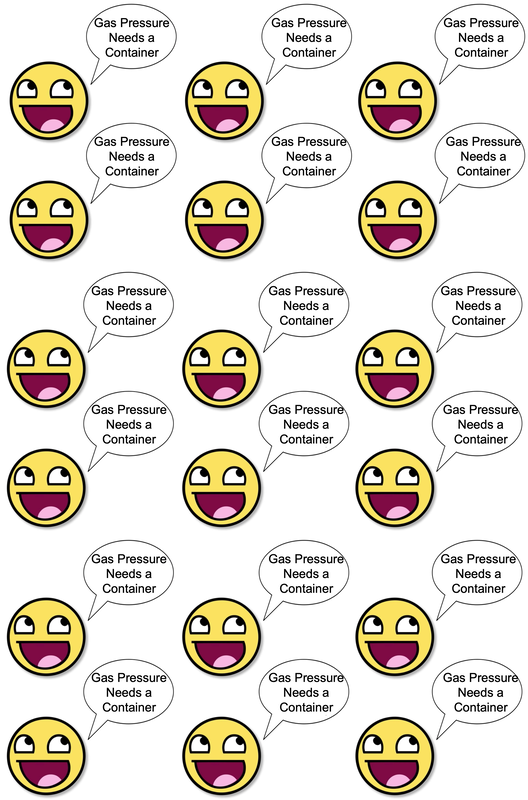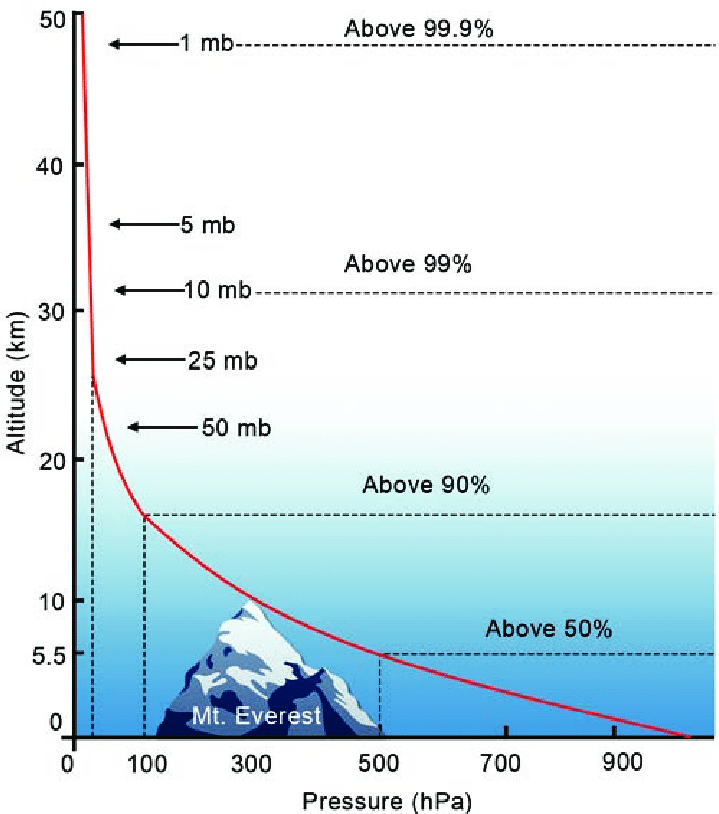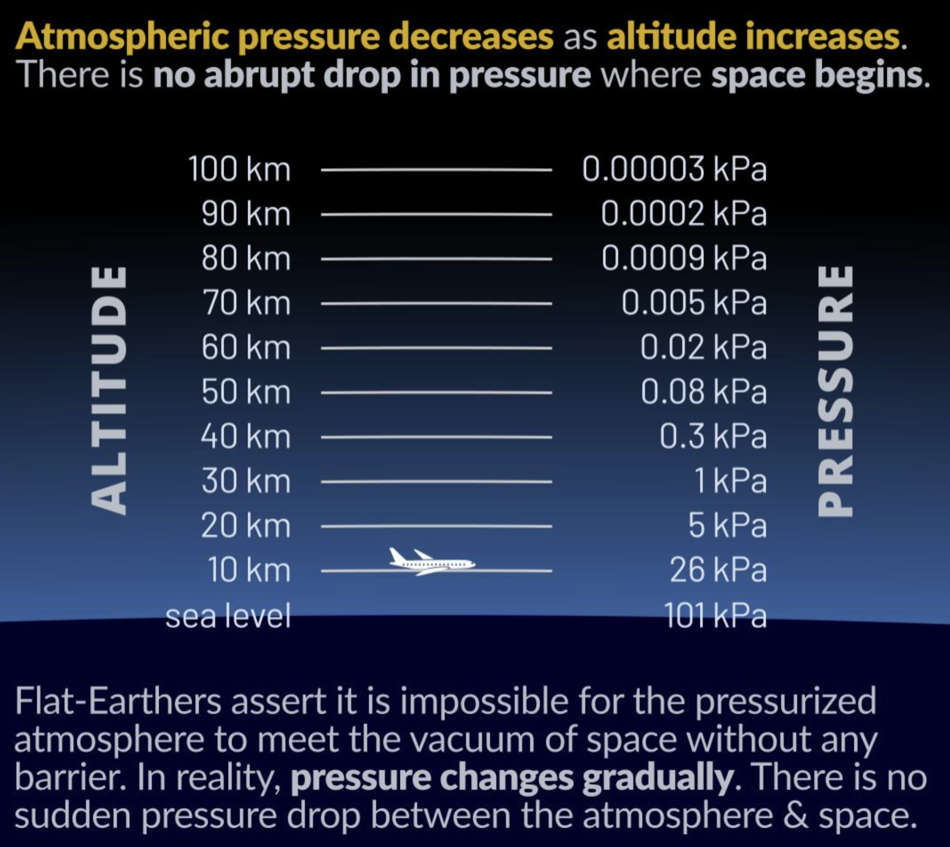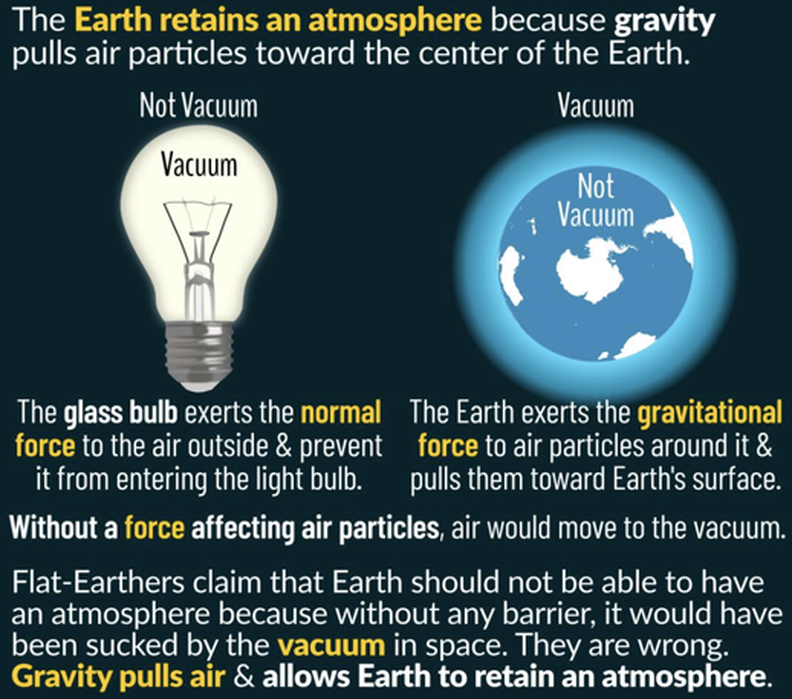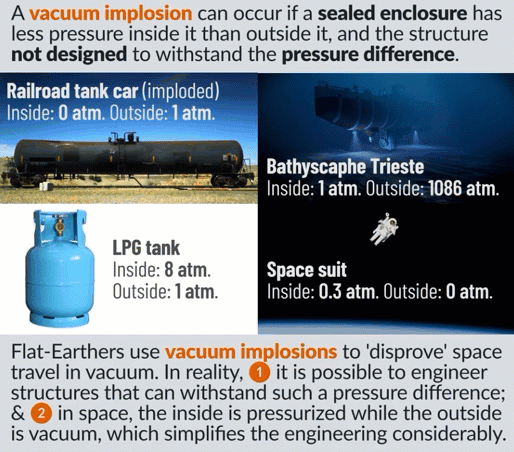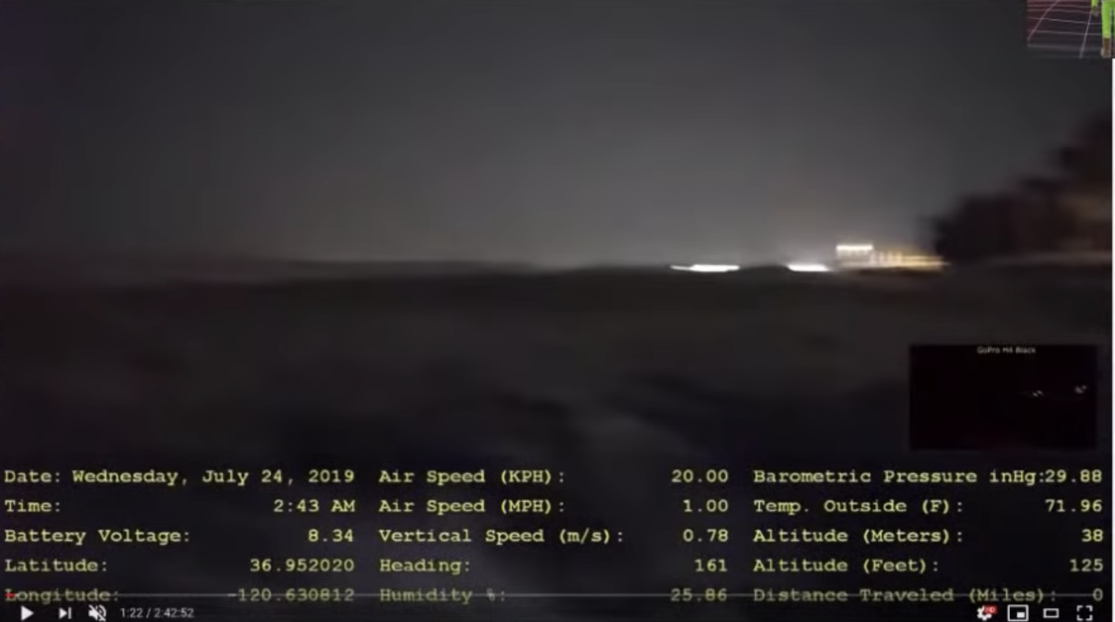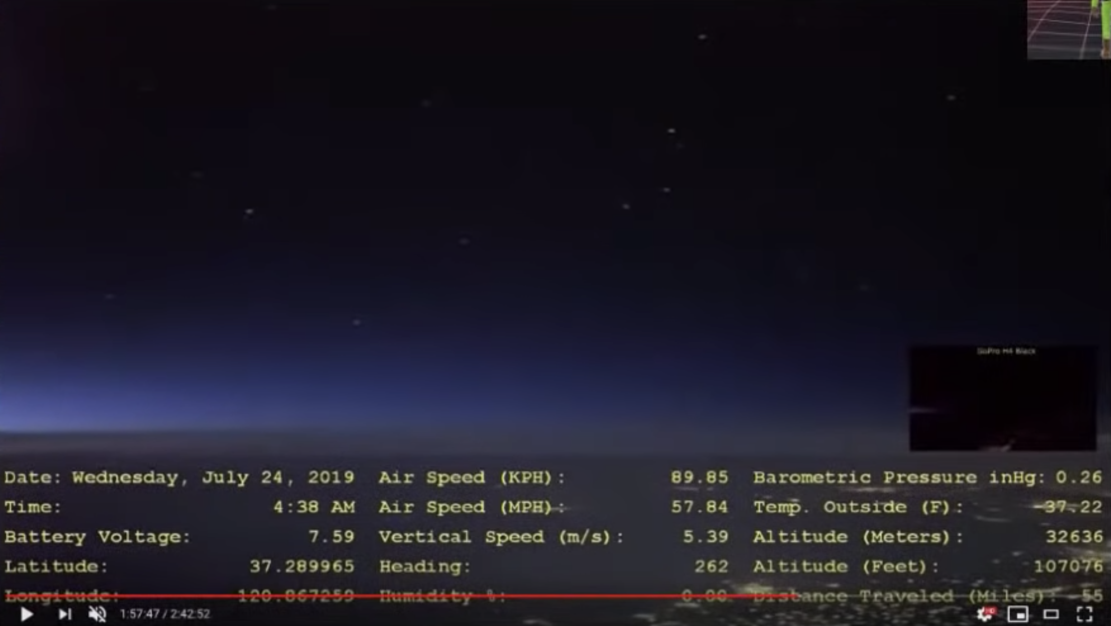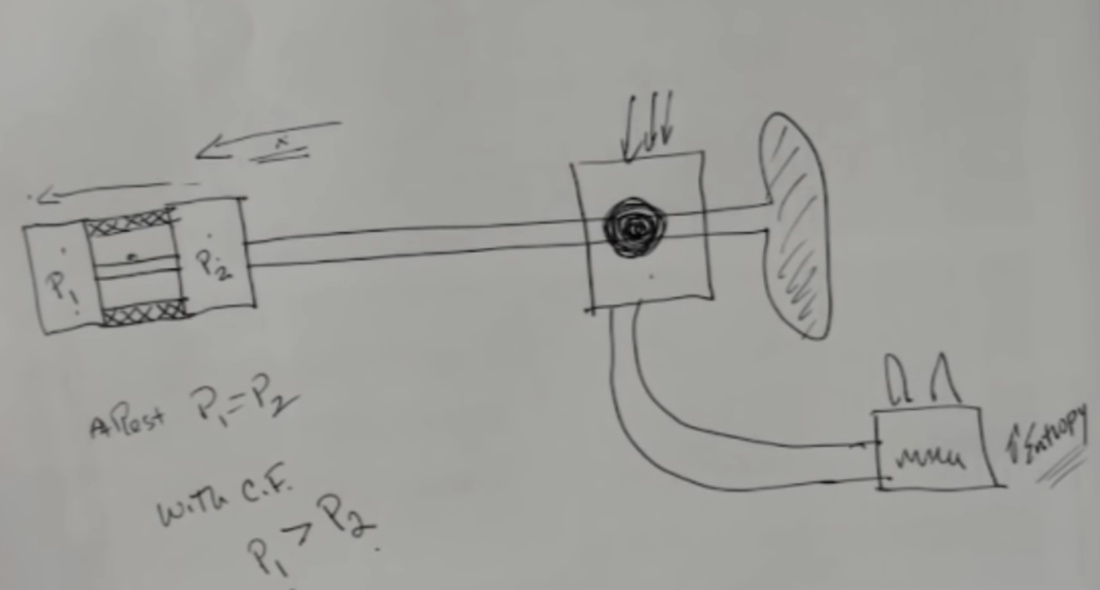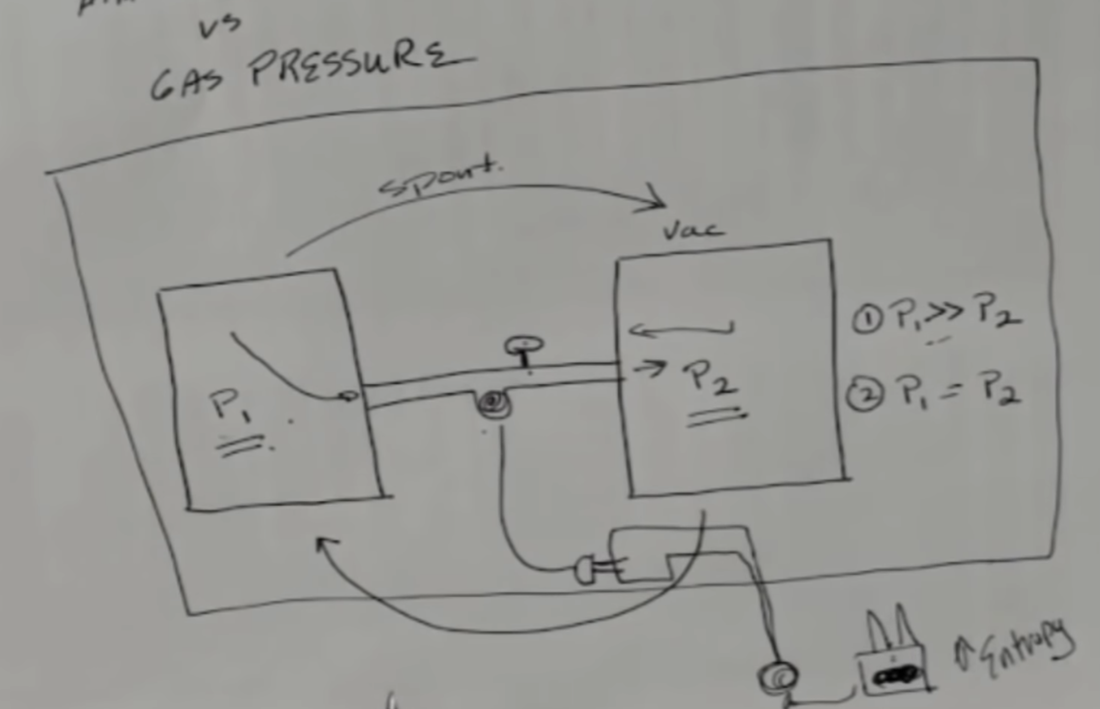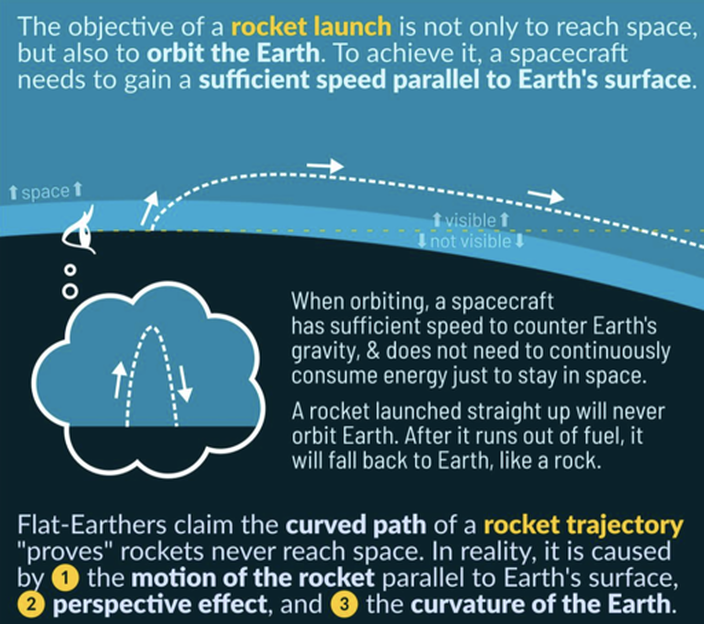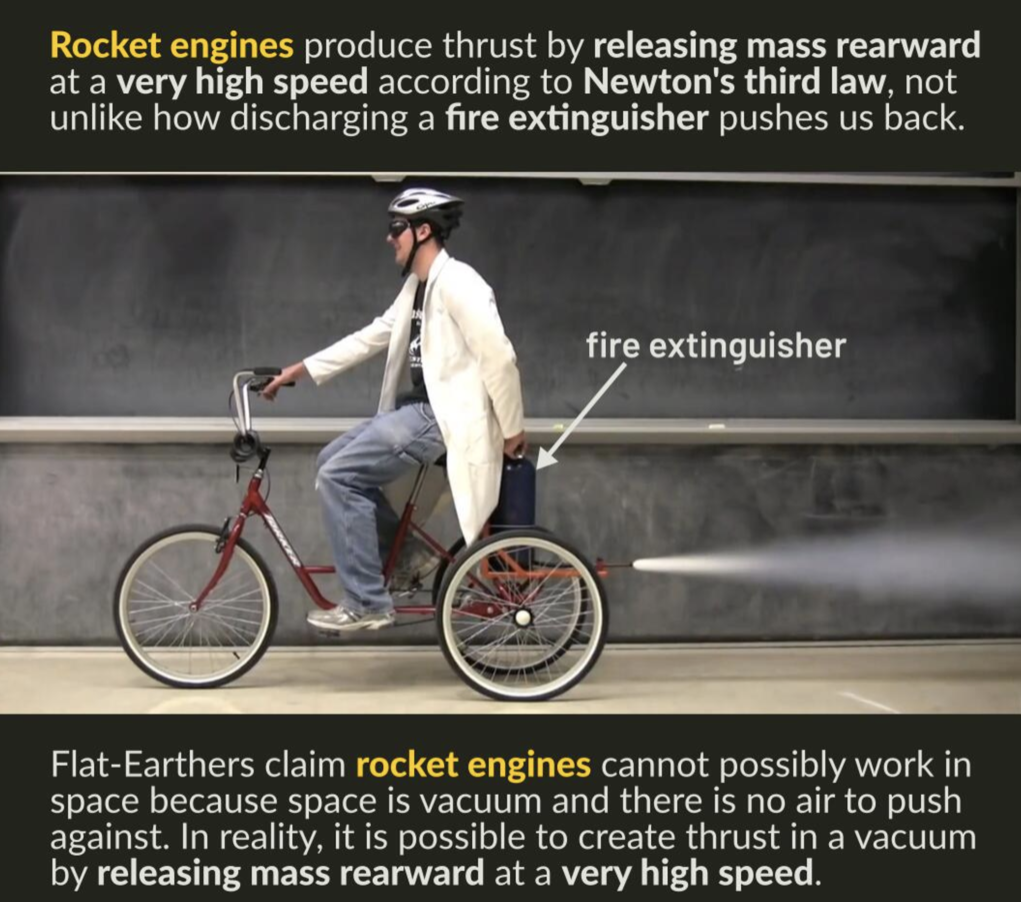2nd law of thermodynamics states the entropy of the universe never decreases. High pressure gases migrate to lower pressurized gas only if no forces are acting. Gravity is a force.
Atmospheric Pressure vs Gas Pressure
Atmospheric pressure is the pressure exerted on a surface by the weight of the atmosphere (a compressible fluid) above it and is usually measured using mercury barometer. The pressure of a gas is the force that the gas exerts on the walls of its container.
Atmospheric Pressure vs Gas Pressure
Atmospheric pressure is the pressure exerted on a surface by the weight of the atmosphere (a compressible fluid) above it and is usually measured using mercury barometer. The pressure of a gas is the force that the gas exerts on the walls of its container.
Pressure differential not vacuum (space is a low pressure)
Top of airplane wing and bottom
A force can cause pressure differential
Hurricane low pressure ... where's the container.
Forces can cause a pressure gradient.
Top of airplane wing and bottom
A force can cause pressure differential
Hurricane low pressure ... where's the container.
Forces can cause a pressure gradient.
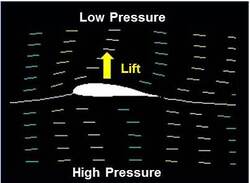
How Wings Lift the Plane
Airplane wings are shaped to make air move faster over the top of the wing. When air moves faster, the pressure of the air decreases. So the pressure on the top of the wing is less than the pressure on the bottom of the wing. The difference in pressure creates a force on the wing that lifts the wing up into the air.
Airplane wings are shaped to make air move faster over the top of the wing. When air moves faster, the pressure of the air decreases. So the pressure on the top of the wing is less than the pressure on the bottom of the wing. The difference in pressure creates a force on the wing that lifts the wing up into the air.
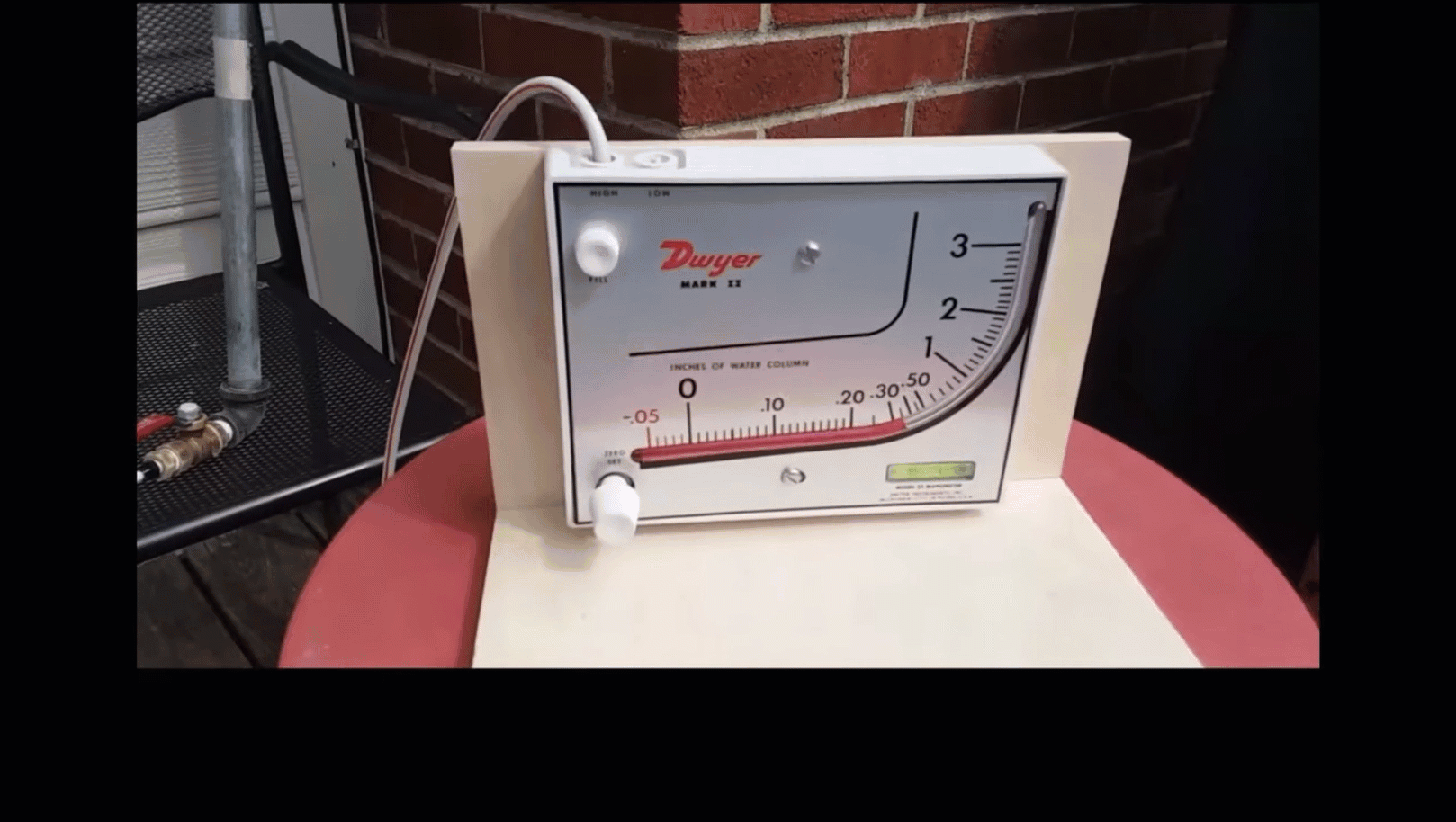
There is a bias all right, it is the same bias that holds the gas in this open pipe. It is the same bias that holds our atmosphere in place and produces the atmospheric pressure gradient. It is called gravity!
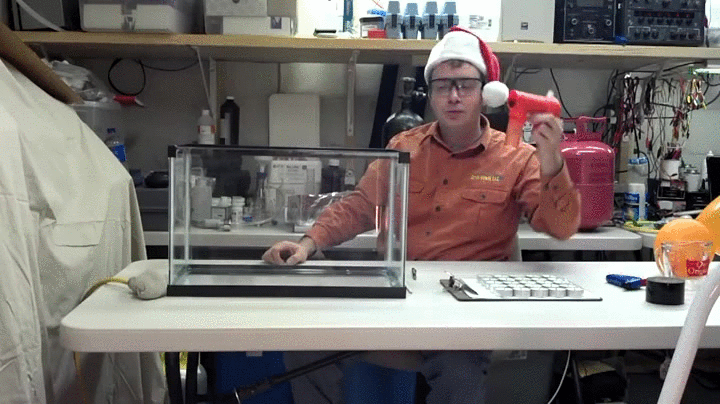
Gas without a container
Sulfur hexafluoride (SF₆) has a density of 6.12 g/L at sea level, considerably higher than the density of air (exactly 5 times more dense). It's therefore allowing experiments like this one, where soap bubble are apparently 'suspended' over a tank.
Sulfur hexafluoride (SF₆) has a density of 6.12 g/L at sea level, considerably higher than the density of air (exactly 5 times more dense). It's therefore allowing experiments like this one, where soap bubble are apparently 'suspended' over a tank.
Gas With No Physical Container...No Problem!
Plasma Gas
Magnetic Field Confinement
LIKE
Atmospheric Gas
Gravitational Field Confinement
Magnetic confinement fusion is an approach to generate thermonuclear fusion power that uses magnetic fields to confine fusion fuel in the form of a plasma. Magnetic confinement is one of two major branches of fusion energy research, along with inertial confinement fusion.
Example with No physical container
Fusion Reactor
Magnetically constricted fusion reactor.
Take energetic plasma, ionized gas, and squeeze it using a magnetic
Field so it will get so dense and so hot that it will start nuclear fusion.
It has been done, but not efficient or useful.
Ionized gas is electrically charged.
Gas molecule bouncing around defines gas, moving around
Electron normally bound to nucleus is not bound anymore.
Is it a fair analogy
In reactor electromagnetic force - It is gravity being applied
Fusion reactors using the same electromagnetic force.
Need a charged ionized gas
Plasma Gas
Magnetic Field Confinement
LIKE
Atmospheric Gas
Gravitational Field Confinement
Magnetic confinement fusion is an approach to generate thermonuclear fusion power that uses magnetic fields to confine fusion fuel in the form of a plasma. Magnetic confinement is one of two major branches of fusion energy research, along with inertial confinement fusion.
Example with No physical container
Fusion Reactor
Magnetically constricted fusion reactor.
Take energetic plasma, ionized gas, and squeeze it using a magnetic
Field so it will get so dense and so hot that it will start nuclear fusion.
It has been done, but not efficient or useful.
Ionized gas is electrically charged.
Gas molecule bouncing around defines gas, moving around
Electron normally bound to nucleus is not bound anymore.
Is it a fair analogy
In reactor electromagnetic force - It is gravity being applied
Fusion reactors using the same electromagnetic force.
Need a charged ionized gas
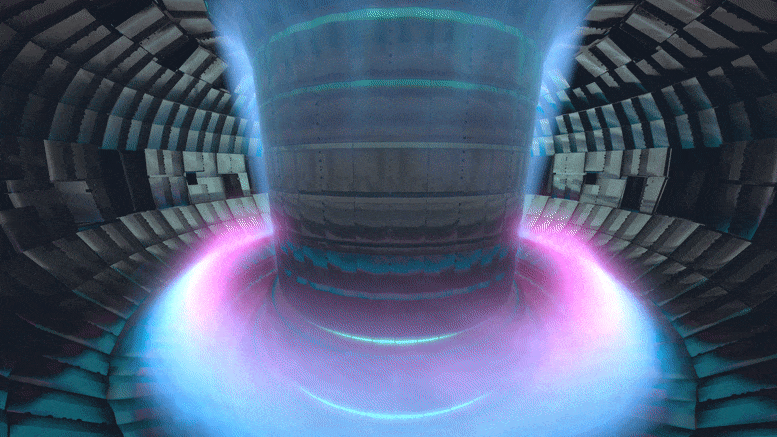
Magnetic confinement fusion is an approach to generate thermonuclear fusion power that uses magnetic fields to confine fusion fuel in the form of a plasma. Magnetic confinement is one of two major branches of fusion energy research, along with inertial confinement fusion.
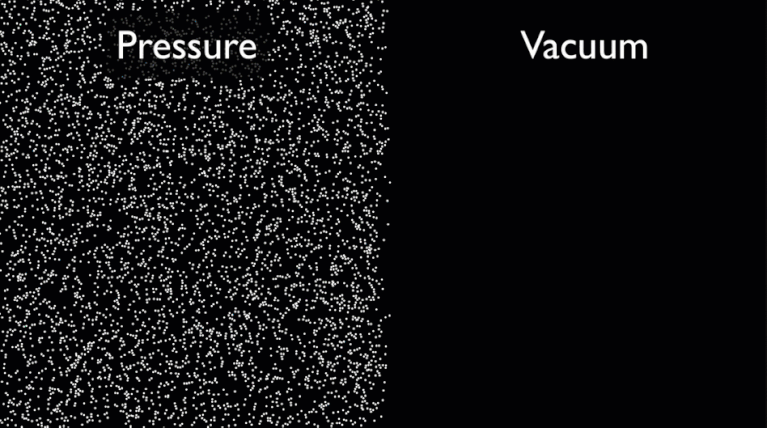
Air Under Pressure near low vacuum conditions.
We all know if you have some air under normal pressure and there is a vacuum next to it, then the air will rush over to fill the vacuum.
We all know if you have some air under normal pressure and there is a vacuum next to it, then the air will rush over to fill the vacuum.

Now there is nothing between the earth's atmosphere and the near vacuum in space so why doesn't the earth's atmosphere get sucked into space?
The answer of course is gravity!
Gravity is holding the atmosphere down but how does that work? How does gravity keep the air in my room under constant pressure and not rush off into space?
To think about how that works you actually have to think about the atmosphere actually is. The atmosphere or the air is a gas, a mixture of mostly nitrogen and oxygen. And like all gases it is just a bunch of molecules flying around.
We are used to thinking of the atmosphere in terms of air pressure, but to understand that you have to consider the motion of individual molecules.
Here is a thought experiment in a simplified universe.
Let's say the universe contained nothing at all except some gas molecules. This molecules would move in straight lines and not change directions unless they had to collide with each other.
If you add a planet like the earth, how will that change things.
The answer of course is gravity!
Gravity is holding the atmosphere down but how does that work? How does gravity keep the air in my room under constant pressure and not rush off into space?
To think about how that works you actually have to think about the atmosphere actually is. The atmosphere or the air is a gas, a mixture of mostly nitrogen and oxygen. And like all gases it is just a bunch of molecules flying around.
We are used to thinking of the atmosphere in terms of air pressure, but to understand that you have to consider the motion of individual molecules.
Here is a thought experiment in a simplified universe.
Let's say the universe contained nothing at all except some gas molecules. This molecules would move in straight lines and not change directions unless they had to collide with each other.
If you add a planet like the earth, how will that change things.
There is no hard boundary between the earth and space and the earth is losing a lot of atmosphere daily to space (luckily the rate it is leaving would take 150 million years to exhaust).
Gas Pressure and Atmospheric pressure are two different things
Atmospheric pressure or barometric pressure is the pressure within the atmosphere of Earth.
The standard atmosphere (symbol: atm) is a unit of pressure defined as 101,325 Pa (1,013.25 hPa), which is equivalent to 1013.25 millibars, 760 mm Hg.
14.7 pounds per square inch (psi)
Pressure = F/A so you can have a pressure by having a force and that force is the gravitational force.
The pressure of a gas is the force exerts on the walls of its container.
Atmospheric pressure or barometric pressure.
It is caused by the gravitational attraction on the atmospheric gases above the surface and is a function of the radius and mass of the planet and the amount and composition of the gases and their vertical distribution in the atmosphere.
It is modified by earth's rotation and local effects such as wind velocity , density variations due to temperature and variations due to composition.
The most important part is there is a pressure gradient that requires a force of some kind and without that force there would not be a pressure gradient inside flat earths dome.
Gas Pressure and Atmospheric pressure are two different things
Atmospheric pressure or barometric pressure is the pressure within the atmosphere of Earth.
The standard atmosphere (symbol: atm) is a unit of pressure defined as 101,325 Pa (1,013.25 hPa), which is equivalent to 1013.25 millibars, 760 mm Hg.
14.7 pounds per square inch (psi)
Pressure = F/A so you can have a pressure by having a force and that force is the gravitational force.
The pressure of a gas is the force exerts on the walls of its container.
Atmospheric pressure or barometric pressure.
It is caused by the gravitational attraction on the atmospheric gases above the surface and is a function of the radius and mass of the planet and the amount and composition of the gases and their vertical distribution in the atmosphere.
It is modified by earth's rotation and local effects such as wind velocity , density variations due to temperature and variations due to composition.
The most important part is there is a pressure gradient that requires a force of some kind and without that force there would not be a pressure gradient inside flat earths dome.
Suddenly there is a strong gravity well and all the gas molecules will tend to move in that direction, and with this potential energy they initially speed up and slosh around but eventually they settle down.
Lets see what happens, the planet has suddenly acquired an atmosphere and not only that, its one where the density of the atmosphere decreases as you get higher.
Most of the molecules are near the earth's surface and bouncing around and colliding with each other and the objects around them. It's those collisions that make air pressure.
Lets see what happens, the planet has suddenly acquired an atmosphere and not only that, its one where the density of the atmosphere decreases as you get higher.
Most of the molecules are near the earth's surface and bouncing around and colliding with each other and the objects around them. It's those collisions that make air pressure.
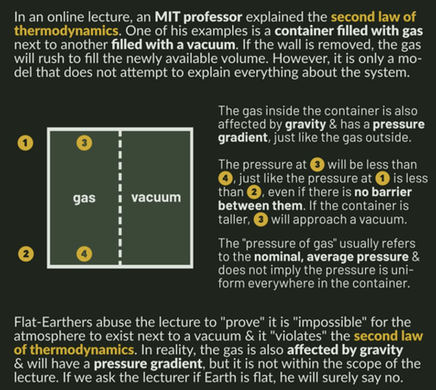
Vacuums don't "suck"
The vacuum argument doesn't hold. Vacuums never “suck” air. ... In fact, at the upper limits of the atmosphere, the air pressure reduces to basically nil. And since there's no real air pressure to speak of up there, then there is no force pushing the air into the empty space. Now, this doesn't mean gravity isn't at work here, quite the contrary it does. Flat earthers lack a basic understanding of how atmospheric pressure works. Towards sea level the pressure IS high, so creating vacuums in those situations WILL have a lot of pressure.
The vacuum argument doesn't hold. Vacuums never “suck” air. ... In fact, at the upper limits of the atmosphere, the air pressure reduces to basically nil. And since there's no real air pressure to speak of up there, then there is no force pushing the air into the empty space. Now, this doesn't mean gravity isn't at work here, quite the contrary it does. Flat earthers lack a basic understanding of how atmospheric pressure works. Towards sea level the pressure IS high, so creating vacuums in those situations WILL have a lot of pressure.
Gas in the Box Problem Modeled
The term “Gas pressure” relates to gases in an enclosed container. The relevant physical laws applying to this mean that
1. In a container, the gas will expand to fill the space (a favourite argument of most flat earthers looking for a “gotcha") however the next point sets out how that differs from atmospheric pressure.
2. Because of that expansion, the gas pressure in that container is CONSTANT throughout. If you measured it at any point, it would be the same, top, bottom, east, west, north, south or centre. There cannot be a gradient.
Athmospheric pressure has gradients. It is higher the closer one gets to the earth and lower as you get higher. Pressures vary wildly even at the same heights, depending on temperatures, topology and moisture. This demonstrates that the pressure is not caused by its expansion capability but by something else.
So, addressing the obvious and much-loved FE trope of “how can you have gas pressure next to a vacuum, the gas would “expand to fill the space". There are two main factors as to why this does not happen.
Gravity. Like ot or not, we have measured it, observed it and detected gravity waves from neutron stars and black holes. It's a thing. It's a fact. Not conjecture, hypothesis a hunch or “theory". It is a “scientific theory" but, then again so is “Humans need oxygen to survive". I urge you to look up the difference between “scientific theory" and “a theory". There is a very definite distinction.
As one gets higher, the air gets thinner and thinner. There are fewer and fewer molecules per cubic metre. This lowers the pressure very, very gradually until it is so low, it ALMOST becomes a vacuum itself. The vacuum of space is not to be confused with, say a “vacuum" cleaner. It does not “suck". It is simply an absence of pressure and matter. So, over a very gentle gradient our air gets thinner and thinner and thinner until there are mere picobars of pressure difference between it and the void of space. Think of it like pouring cold liquid slowly into one side of a bath and hot from the other, at some point where they meet, they find an equilibrium. The temperature there is a happy medium between the hot and the cold. The same is true for the relative pressures of the atmosphere and space.
Now, the easiest way for you to see this yourself is to obtain a gas container with a pressure gauge on it and a barometer. Take readings at the bottom of a large hill, or better yet, a mountain. Then walk or drive up that hill or mountain and take another reading at the top.
What you will find is, that the container still shows the same pressure reading. The barometer's will be lower.
It will work every single time and will hopefully prove to you, once and for all that
a. Atmospheric pressure is NOT the same as gas pressure.
b. There cannot be a dome over the earth, otherwise the barometer would not work
c. It is perfectly okay to believe in God AND accept that science has an explanation for certain things.
d. You, or someone who taught you, utterly misinterpreted the relevant sections of the bible and, with human fallibility made a mistake that the planet is flat.
1. In a container, the gas will expand to fill the space (a favourite argument of most flat earthers looking for a “gotcha") however the next point sets out how that differs from atmospheric pressure.
2. Because of that expansion, the gas pressure in that container is CONSTANT throughout. If you measured it at any point, it would be the same, top, bottom, east, west, north, south or centre. There cannot be a gradient.
Athmospheric pressure has gradients. It is higher the closer one gets to the earth and lower as you get higher. Pressures vary wildly even at the same heights, depending on temperatures, topology and moisture. This demonstrates that the pressure is not caused by its expansion capability but by something else.
So, addressing the obvious and much-loved FE trope of “how can you have gas pressure next to a vacuum, the gas would “expand to fill the space". There are two main factors as to why this does not happen.
Gravity. Like ot or not, we have measured it, observed it and detected gravity waves from neutron stars and black holes. It's a thing. It's a fact. Not conjecture, hypothesis a hunch or “theory". It is a “scientific theory" but, then again so is “Humans need oxygen to survive". I urge you to look up the difference between “scientific theory" and “a theory". There is a very definite distinction.
As one gets higher, the air gets thinner and thinner. There are fewer and fewer molecules per cubic metre. This lowers the pressure very, very gradually until it is so low, it ALMOST becomes a vacuum itself. The vacuum of space is not to be confused with, say a “vacuum" cleaner. It does not “suck". It is simply an absence of pressure and matter. So, over a very gentle gradient our air gets thinner and thinner and thinner until there are mere picobars of pressure difference between it and the void of space. Think of it like pouring cold liquid slowly into one side of a bath and hot from the other, at some point where they meet, they find an equilibrium. The temperature there is a happy medium between the hot and the cold. The same is true for the relative pressures of the atmosphere and space.
Now, the easiest way for you to see this yourself is to obtain a gas container with a pressure gauge on it and a barometer. Take readings at the bottom of a large hill, or better yet, a mountain. Then walk or drive up that hill or mountain and take another reading at the top.
What you will find is, that the container still shows the same pressure reading. The barometer's will be lower.
It will work every single time and will hopefully prove to you, once and for all that
a. Atmospheric pressure is NOT the same as gas pressure.
b. There cannot be a dome over the earth, otherwise the barometer would not work
c. It is perfectly okay to believe in God AND accept that science has an explanation for certain things.
d. You, or someone who taught you, utterly misinterpreted the relevant sections of the bible and, with human fallibility made a mistake that the planet is flat.
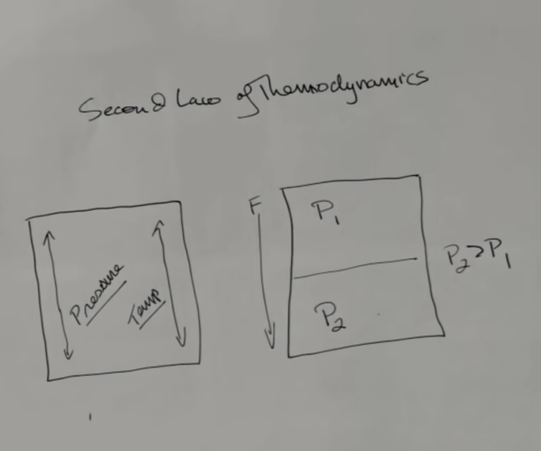
Does volume require a container?
Outline of box of water.
Only thing containing it is the bottom of the lake.
When you discuss a volume of something, like water or air you do not need a container.
Atmosphere has a known temperature and pressure gradient.
50 km, pressure drops to almost zero.
Second law of thermo and entropy.
Pressure rises from high pressure to low pressure until pressure equalsizes.
Can we make move air move back.
We can put a pump in
We can however decreases the local entropy in this system by increasing the entropy in the surrounding systems.
How? Increase entropy by boiling water to steam, and use steam in a turbine to generate electricity to turn on the pump. By turning on the pump we can reverse entropy.
Outline of box of water.
Only thing containing it is the bottom of the lake.
When you discuss a volume of something, like water or air you do not need a container.
Atmosphere has a known temperature and pressure gradient.
50 km, pressure drops to almost zero.
Second law of thermo and entropy.
Pressure rises from high pressure to low pressure until pressure equalsizes.
Can we make move air move back.
We can put a pump in
We can however decreases the local entropy in this system by increasing the entropy in the surrounding systems.
How? Increase entropy by boiling water to steam, and use steam in a turbine to generate electricity to turn on the pump. By turning on the pump we can reverse entropy.
At rest P1 = P2
Spin the centrifuge and create a great deal of centrifugal force. With centrifugal force P1> P2
Work is the displacement of mass in the direction of an applied force (mgh).
We are performing work on the mass of gas and displacing that gas in the direction of the centrifugal force.
Usually use this in a lab.
PV = nRT
Have to have gas pressure for a pressure gradient.
Spin the centrifuge and create a great deal of centrifugal force. With centrifugal force P1> P2
Work is the displacement of mass in the direction of an applied force (mgh).
We are performing work on the mass of gas and displacing that gas in the direction of the centrifugal force.
Usually use this in a lab.
PV = nRT
Have to have gas pressure for a pressure gradient.
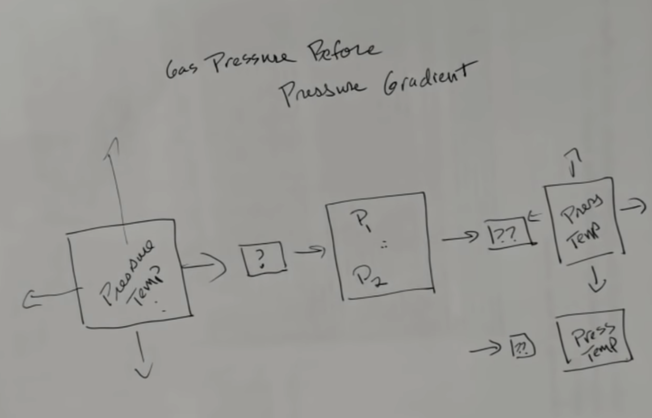
1) If they claim you have gas pressure before you have a pressure gradient, at what time and under what conditions did you have uniform gas pressure before a gradient formed?
No evidence.
What caused that homogeneous system to form a pressure gradient?
2) And why, if we have a pressure gradient now, does the gas not disperse in all directions
No answer.
If the 2nd law of thermodynamics was acting on an ideal gas in our atmosphere, that gas would disperse into the universe and we would have no gas pressure
AND if there was a container over that earth, that gas would expand to fill the available space and we would have a uniform pressure and temperature throughout the atmosphere.
What we do see is a pressure gradient, which demands there is an external force acting on the mass of the gas in our atmosphere. You have to have an external force.
The fact there is a pressure gradient mandates a downward force which we call gravity.
No evidence.
What caused that homogeneous system to form a pressure gradient?
2) And why, if we have a pressure gradient now, does the gas not disperse in all directions
No answer.
If the 2nd law of thermodynamics was acting on an ideal gas in our atmosphere, that gas would disperse into the universe and we would have no gas pressure
AND if there was a container over that earth, that gas would expand to fill the available space and we would have a uniform pressure and temperature throughout the atmosphere.
What we do see is a pressure gradient, which demands there is an external force acting on the mass of the gas in our atmosphere. You have to have an external force.
The fact there is a pressure gradient mandates a downward force which we call gravity.
The vacuum just represents ZERO pressure pressing back on the Earth's atmosphere.
Now let's consider the gaseous atmosphere of the Earth.
In a gas the average molecular speed is given by √(3RT/M)
where:
R = molar gas constant = 8.31447 J mol⁻¹ K⁻¹
T = temperature in kelvin = 190K (at 100km altitude) to 290K (at 0km altitude) [chart]
M = molar mass (g/mole) =
So let's compute some velocities and since this is an average, we will double this value so we're looking at much faster than average molecules. We will also use the hotter temperature of 290K even though by the time it's 100km up in the atmosphere it would have necessarily cooled down to ~190K.
hydrogen (H) = √(3RT/1.00794) = 2678.9 m/s -- WOAH, that's pretty fast... 2× = 5357.8 m/s
oxygen (O) = √(3RT/15.9994) = 672.4 m/s -- and 2× = 1344.8 m/s
oxygen gas (O₂) = √(3RT/31.9988) = 475.46 m/s -- and 2× = 950.92 m/s
Sulfur Hexafluoride √(3RT/146) = 222 m/s (but this is a molecule with rotational/vibrational energies along with translational). So that lowers the speed significantly.
Now we can compare this speed against the Escape Velocity required for an object to leave the influence of Earth's gravity.
At 0km altitude Escape Velocity is ~11180 m/s
At 100km altitude Escape Velocity is ~11100 m/s
To escape the pull of Earth's gravity our particle would need to be going in excess of 11100 m/s** but as we've shown, even with the fastest hydrogen (H) molecules they are MOSTLY going maybe half that. Now if you add in some extra solar radiation hitting a high speed molecule (exospheric H can reach 1800K/6674.2m/s average with MUCH higher peaks, perhaps up to 18000m/s) -- so sure, some gas particles are going to escape, the lightest ones are most likely to do so. One estimate is that we loose about 95,000 tonnes of Hydrogen every year (3kg/sec). Other gases do not escape at a very significant rate -- these calculations show why.
For more details see Atmospheric Escape
** they also need to not hit other molecules before they escape, this is called the 'mean free path', and there are a few other considerations, but this is a good first approximation.
Conclusion
Earth's gravity is what holds our atmosphere to the planet and we see here that the force of gravity, which creates the 'Escape Velocity', far exceeds the molecular speeds for most cases. So the force of Gravity works exactly like the intermolecular bonds in our marble, which holds the molecules with sufficient force to prevent them from escaping EVEN THOUGH there is nothing in space pushing them down.
Now let's consider the gaseous atmosphere of the Earth.
In a gas the average molecular speed is given by √(3RT/M)
where:
R = molar gas constant = 8.31447 J mol⁻¹ K⁻¹
T = temperature in kelvin = 190K (at 100km altitude) to 290K (at 0km altitude) [chart]
M = molar mass (g/mole) =
- hydrogen (H) = 1.00794
- oxygen (O) = 15.9994
- oxygen gas (O₂) = 31.9988 (just 2 × oxygen)
So let's compute some velocities and since this is an average, we will double this value so we're looking at much faster than average molecules. We will also use the hotter temperature of 290K even though by the time it's 100km up in the atmosphere it would have necessarily cooled down to ~190K.
hydrogen (H) = √(3RT/1.00794) = 2678.9 m/s -- WOAH, that's pretty fast... 2× = 5357.8 m/s
oxygen (O) = √(3RT/15.9994) = 672.4 m/s -- and 2× = 1344.8 m/s
oxygen gas (O₂) = √(3RT/31.9988) = 475.46 m/s -- and 2× = 950.92 m/s
Sulfur Hexafluoride √(3RT/146) = 222 m/s (but this is a molecule with rotational/vibrational energies along with translational). So that lowers the speed significantly.
Now we can compare this speed against the Escape Velocity required for an object to leave the influence of Earth's gravity.
At 0km altitude Escape Velocity is ~11180 m/s
At 100km altitude Escape Velocity is ~11100 m/s
To escape the pull of Earth's gravity our particle would need to be going in excess of 11100 m/s** but as we've shown, even with the fastest hydrogen (H) molecules they are MOSTLY going maybe half that. Now if you add in some extra solar radiation hitting a high speed molecule (exospheric H can reach 1800K/6674.2m/s average with MUCH higher peaks, perhaps up to 18000m/s) -- so sure, some gas particles are going to escape, the lightest ones are most likely to do so. One estimate is that we loose about 95,000 tonnes of Hydrogen every year (3kg/sec). Other gases do not escape at a very significant rate -- these calculations show why.
For more details see Atmospheric Escape
** they also need to not hit other molecules before they escape, this is called the 'mean free path', and there are a few other considerations, but this is a good first approximation.
Conclusion
Earth's gravity is what holds our atmosphere to the planet and we see here that the force of gravity, which creates the 'Escape Velocity', far exceeds the molecular speeds for most cases. So the force of Gravity works exactly like the intermolecular bonds in our marble, which holds the molecules with sufficient force to prevent them from escaping EVEN THOUGH there is nothing in space pushing them down.
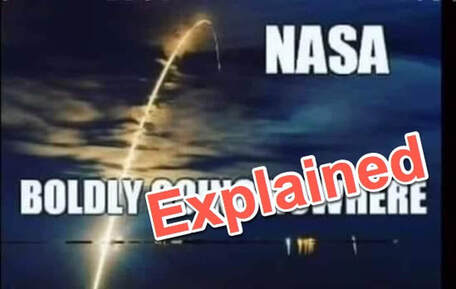
This flight path can be rationally explained:
1) Rocket launches have a curved trajectory because their objective is not only to reach space but also to enter Earth orbit. To achieve it, a spacecraft needs to gain a sufficient horizontal speed, parallel to Earth’s surface.
2) The most efficient way to reach orbit is to initially travel straight up to overcome air resistance, then tilt onto its side and gradually increase this tilt until the rocket is parallel to Earth’s surface.
3) ===> If the rocket launches straight up, it will reach space faster with less energy. But it will not have the required velocity to orbit. The rocket will have to continuously spend energy only to remain up there. Once it runs out of fuel, the rocket will fall back to the Earth very fast. It’s not rocket science.
4) From the vantage point of an observer near the launch location, the rocket will eventually appear to go “down.” It is due to the aforementioned horizontal motion of the rocket: the rocket does not go only up, but also away. The perspective effect also contributes to the observation: the rocket is going farther, and as it goes farther, it will appear closer and closer to the horizon.
5) And last but not least, the rocket follows Earth’s surface, which is curved. The rocket will eventually disappear below the horizon, just like a ship traveling away will start disappearing from the bottom first.
1) Rocket launches have a curved trajectory because their objective is not only to reach space but also to enter Earth orbit. To achieve it, a spacecraft needs to gain a sufficient horizontal speed, parallel to Earth’s surface.
2) The most efficient way to reach orbit is to initially travel straight up to overcome air resistance, then tilt onto its side and gradually increase this tilt until the rocket is parallel to Earth’s surface.
3) ===> If the rocket launches straight up, it will reach space faster with less energy. But it will not have the required velocity to orbit. The rocket will have to continuously spend energy only to remain up there. Once it runs out of fuel, the rocket will fall back to the Earth very fast. It’s not rocket science.
4) From the vantage point of an observer near the launch location, the rocket will eventually appear to go “down.” It is due to the aforementioned horizontal motion of the rocket: the rocket does not go only up, but also away. The perspective effect also contributes to the observation: the rocket is going farther, and as it goes farther, it will appear closer and closer to the horizon.
5) And last but not least, the rocket follows Earth’s surface, which is curved. The rocket will eventually disappear below the horizon, just like a ship traveling away will start disappearing from the bottom first.
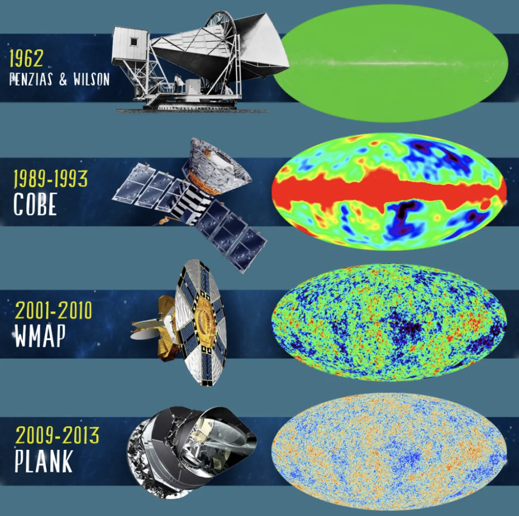
Over recent decades, cosmological simulations of galaxy formation have been instrumental in advancing our understanding of structure and galaxy formation in the Universe. These simulations follow the nonlinear evolution of galaxies, modelling a variety of physical processes over an enormous range of time and length scales. A better understanding of the relevant physical processes, improved numerical methods and increased computing power have led to simulations that can reproduce a large number of the observed galaxy properties. Modern simulations model dark matter, dark energy and ordinary matter in an expanding space-time starting from well-defined initial conditions.
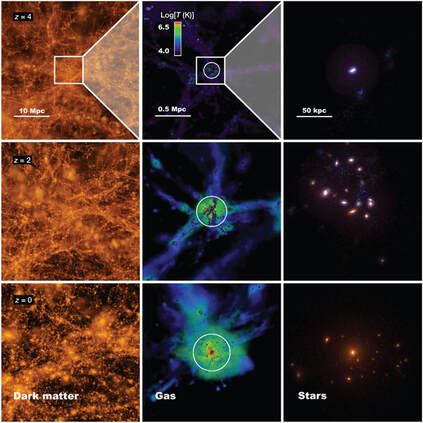
Key points
The formation of structures and galaxies in the Universe, which consists of ordinary matter, dark energy and dark matter, involves various physical processes such as gravity, gas cooling, star formation, supernova feedback, supermassive black hole feedback, stellar evolution, radiation, magnetic fields, cosmic rays and more.
Cosmological simulations allow detailed studies of the formation and evolution of structures and galaxies in the cosmos, starting from smooth initial conditions constrained through observations of the cosmic microwave background, yielding detailed predictions of the galaxy population at different epochs of the Universe.
The dark matter component is typically numerically modelled through the N-body approach. Here, the dark matter phase-space distribution is sampled by an ensemble of phase-space sampling points, resulting in a Monte Carlo scheme, to follow its dynamics, which are governed by the collisionless Boltzmann equation.
The gas content of the baryonic matter component is, in its simplest form, described through the Euler equations, discretized with Eulerian, Lagrangian or arbitrary Lagrangian–Eulerian schemes, coupled to other physical processes such as gravity, cooling processes, feedback processes and star formation.
Alternative forms of dark matter, dark energy and gravity can also be explored through suitable modified simulation methods to test and constrain such theories in the context of structure and galaxy formation, by comparing to observational data such as galaxy surveys, leading to important insights into the overall cosmological framework of structure formation and cosmological parameters.
The formation of structures and galaxies in the Universe, which consists of ordinary matter, dark energy and dark matter, involves various physical processes such as gravity, gas cooling, star formation, supernova feedback, supermassive black hole feedback, stellar evolution, radiation, magnetic fields, cosmic rays and more.
Cosmological simulations allow detailed studies of the formation and evolution of structures and galaxies in the cosmos, starting from smooth initial conditions constrained through observations of the cosmic microwave background, yielding detailed predictions of the galaxy population at different epochs of the Universe.
The dark matter component is typically numerically modelled through the N-body approach. Here, the dark matter phase-space distribution is sampled by an ensemble of phase-space sampling points, resulting in a Monte Carlo scheme, to follow its dynamics, which are governed by the collisionless Boltzmann equation.
The gas content of the baryonic matter component is, in its simplest form, described through the Euler equations, discretized with Eulerian, Lagrangian or arbitrary Lagrangian–Eulerian schemes, coupled to other physical processes such as gravity, cooling processes, feedback processes and star formation.
Alternative forms of dark matter, dark energy and gravity can also be explored through suitable modified simulation methods to test and constrain such theories in the context of structure and galaxy formation, by comparing to observational data such as galaxy surveys, leading to important insights into the overall cosmological framework of structure formation and cosmological parameters.

